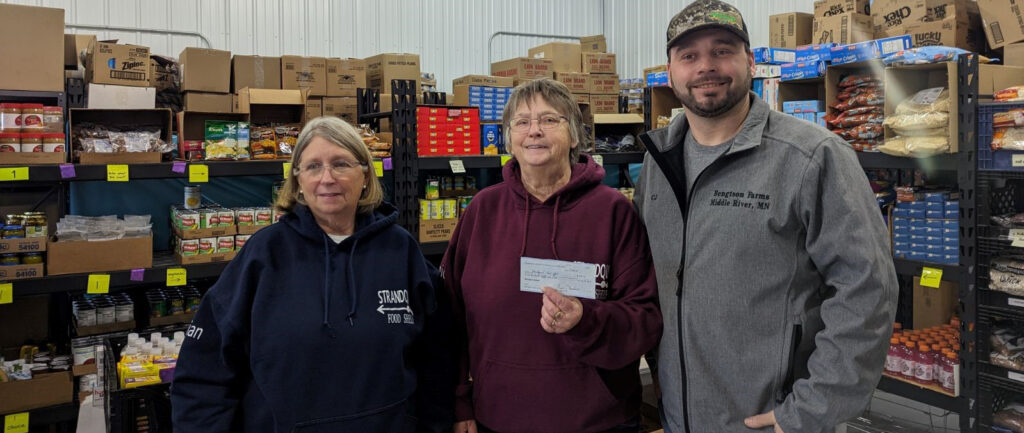Jay Zielske is a grateful man.
After noticing lumps on his right jawline while shaving, Zielske was diagnosed with Stage IV melanoma in 2014. In the midst of a busy morning in May 2019, Zielske visited Minnesota Soybean’s headquarters during Melanoma Awareness Month to give an update on his health.
“I’m incredibly blessed and I’m reminded of it all the time,” says Zielske, who recently lost a friend to melanoma. “It’s very easy to take things for granted, but there have been countless reminders about how fortunate and lucky I’ve been.”
Zielske was profiled in the May-June 2018 issue of Soybean Business, where he recounted his experiences living with melanoma.
“My story is very atypical,” he says. “I sailed through the treatments and didn’t have any side effects. I’m incredibly blessed and am reminded of it all the time.”
Zielske has been taking regular PET scans every four months. Last December, his doctor determined his tests could be limited to six-month intervals. Zielske is remaining diligent, making sure he applies sunscreen multiple times a day and limits his sun exposure.

“There are better tools than they’re used to be and I’ve had very good results with immunotherapy, but it’s not a slam dunk,” he says. “That’s a sobering thought.”
Zielske, an agronomist and account manager with Pioneer, often talks with farmers about how they can use preventive measures to reduce their chances of skin cancer. He frequently mentions the dangers of melanoma during agronomy conferences in the winter. After his visit with Minnesota Soybean, Zielske was heading out to shoot a YouTube video about skin cancer prevention.
“I still try to reach out as much as I can and spread the word,” says Zielske, who tweets about his agronomy and melanoma awareness (@seedzeke).
Melanoma is the most deadly and dangerous form of skin cancer, but can be easily treatable with early detection. Nearly 200,000 cases of melanoma will be diagnosed in 2019 in the U.S., and about one in five Americans will be diagnosed with a form of skin cancer in their lifetimes.
“When it comes to melanoma, you can’t be too careful,” Zielske says. “Stories like mine, as far as seemingly a success story, are the exception and not the rule. But catching melanoma early, it’s very survivable.”
Zielske tells farmers to apply sunscreen multiple times a day and search their bodies for abnormal moles. But even self-body searches don’t cover all parts – cancerous moles can often be found on a person’s back.
“I’ve met 10 other people in ag who have melanoma, and nine of them discovered theirs on their back,” he says. “When’s the last time you saw what your back looked liked? Have someone check it out.”
Zielske says farmers shouldn’t let their guard down when riding in their tractors or combines.
“A lot of farmers think they’re fine when they’re in the cab of the tractor or truck, but that’s a misconception,” he says. “You still get UV exposure in the truck or combine, so those same preventive measures hold even when you’re in a vehicle.”
As he nears the five year anniversary of his diagnosis, Zielske is optimistic about his long-term health and remains determined to counsel others.
“I think this is my calling now. If there is a reason of ‘why me?’, it’s because I’m a survivor,” he says. “I won’t be afraid to tell my story and putting it out there to save somebody else, because watching someone die from cancer isn’t pleasant.”
The ABCDEs of Melanoma
A – Asymmetrical Shape
Melanoma lesion are often irregular, or not symmetrical, in shape. Benign moles are usually symmetrical.
B – Border
Typically, non-cancerous moles have smooth, even borders. Melanoma lesions usually have irregular borders that are difficult to define.
C – Color
The presence of more than one color (blue, black, brown, tan, etc.) or the uneven distribution of color can sometimes be a warning sign of melanoma. Benign moles are usually a single shade of brown or tan.
D – Diameter
Melanoma lesions are often greater than 6 millimeters in diameter (about the size of a pencil eraser).
E – Evolution (or Change)
The evolution of your mole(s) has become the most important factor to consider when it comes to diagnosing melanoma. Knowing what is normal for YOU could save your life.







